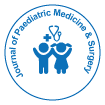हमारा समूह 1000 से अधिक वैज्ञानिक सोसायटी के सहयोग से हर साल संयुक्त राज्य अमेरिका, यूरोप और एशिया में 3000+ वैश्विक सम्मेलन श्रृंखला कार्यक्रम आयोजित करता है और 700+ ओपन एक्सेस जर्नल प्रकाशित करता है जिसमें 50000 से अधिक प्रतिष्ठित व्यक्तित्व, प्रतिष्ठित वैज्ञानिक संपादकीय बोर्ड के सदस्यों के रूप में शामिल होते हैं।
ओपन एक्सेस जर्नल्स को अधिक पाठक और उद्धरण मिल रहे हैं
700 जर्नल और 15,000,000 पाठक प्रत्येक जर्नल को 25,000+ पाठक मिल रहे हैं
में अनुक्रमित
- गूगल ज्ञानी
- आईसीएमजेई
उपयोगी कड़ियां
एक्सेस जर्नल खोलें
इस पृष्ठ को साझा करें
अमूर्त
Management of Inguinal Hernias in Pediatric Patients: A Retrospective Study
Sara A Mansfield
Background: Simulation- grounded education (SBE) has led to significant changes in healthcare education. Still, SBE has frequently been grounded on available coffers and original moxie rather than a methodical approach to class development. The end of this study was to perform abi-national requirements assessment to identify and prioritise procedures in a paediatric surgery class that can be supported using SBE.
Methods: A modified 3- round Delphi fashion was used to gather agreement from education leaders and trainees in paediatric surgery in Australia and Aotearoa New Zealand (ANZ). Round 1 linked all procedures a recently specialised paediatric surgeon should be suitable to perform. In Round 2, each procedure was explored for the need for SBE using the Copenhagen Academy for Medical Education and Simulation (CAMES) Needs- Assessment Formula (NAF). This pre-prioritised list from Round 2 was transferred back to actors for final rejection and ranking in Round 3.
Results: 88 actors were linked and invited. From 174 procedures linked in Round 1, 71 procedures were grouped and categorised for Round 2 using the CAMES NAF. In Round 3, 17 procedures were excluded performing in 54 procedures. Appendectomy, inguinal her noisome, and central venous access were the loftiest rank procedures after prioritisation in Round 3. There was a strong correlation (r = 0.99) between the NAF score and the prioritised ranking, as well as between advisers and trainees (r = 0.92 in Round 2 and0.98 in Round 3).
Conclusion: The prioritised list represents an agreement document decided upon by education leaders and stakeholders in paediatric surgery. These procedures should be an integral part of the SBE of paediatric surgeons in the region.
विषयानुसार पत्रिकाएँ
- अंक शास्त्र
- अभियांत्रिकी
- आनुवंशिकी एवं आण्विक जीवविज्ञान
- इम्यूनोलॉजी और माइक्रोबायोलॉजी
- औषधि विज्ञान
- कंप्यूटर विज्ञान
- कृषि और जलकृषि
- केमिकल इंजीनियरिंग
- चिकित्सीय विज्ञान
- जीव रसायन
- नर्सिंग एवं स्वास्थ्य देखभाल
- नैदानिक विज्ञान
- नैनो
- पदार्थ विज्ञान
- पर्यावरण विज्ञान
- पशु चिकित्सा विज्ञान
- पादप विज्ञान
- बायोमेडिकल साइंसेज
- भूविज्ञान और पृथ्वी विज्ञान
- भोजन एवं पोषण
- भौतिक विज्ञान
- रसायन विज्ञान
- व्यवसाय प्रबंधन
- सामाजिक एवं राजनीतिक विज्ञान
- सामान्य विज्ञान
- सूचना विज्ञान
क्लिनिकल एवं मेडिकल जर्नल
- आणविक जीव विज्ञान
- आनुवंशिकी
- इम्मुनोलोगि
- एनेस्थिसियोलॉजी
- कार्डियलजी
- कीटाणु-विज्ञान
- कैंसर विज्ञान
- गैस्ट्रोएंटरोलॉजी
- ज़हरज्ञान
- तंत्रिका-विज्ञान
- त्वचा विज्ञान
- दंत चिकित्सा
- दवा
- नर्सिंग
- नेत्र विज्ञान
- नेफ्रोलॉजी
- नैदानिक अनुसंधान
- पल्मोनोलॉजी
- प्रजनन चिकित्सा
- बच्चों की दवा करने की विद्या
- भौतिक चिकित्सा एवं पुनर्वास
- मधुमेह और एंडोक्राइनोलॉजी
- मनश्चिकित्सा
- रुधिर
- रेडियोलोजी
- शल्य चिकित्सा
- संक्रामक रोग
- स्वास्थ्य देखभाल
- हड्डी रोग

 English
English  Spanish
Spanish  Chinese
Chinese  Russian
Russian  German
German  French
French  Japanese
Japanese  Portuguese
Portuguese  Telugu
Telugu